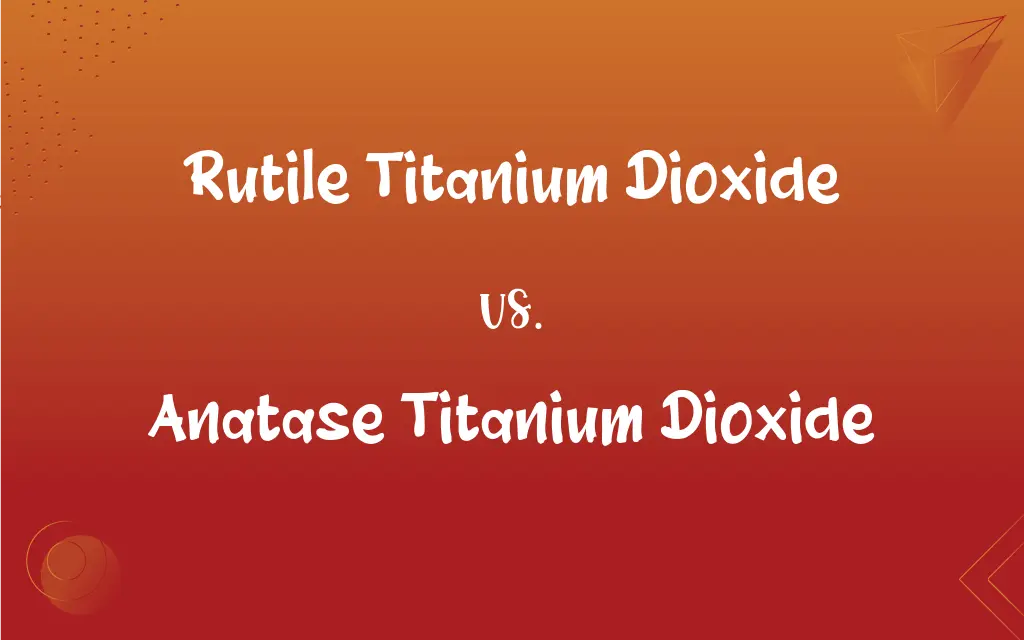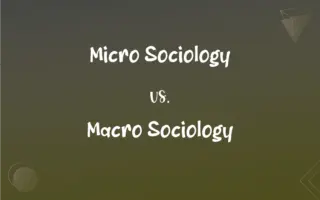Rutile Titanium Dioxide vs. Anatase Titanium Dioxide: What's the Difference?
Edited by Aimie Carlson || By Janet White || Published on March 3, 2024
Rutile titanium dioxide is thermally stable with high refractive index, used in paints and sunscreens; anatase titanium dioxide is less stable, used in photocatalysis.

Key Differences
Rutile titanium dioxide is a naturally occurring form of TiO2, known for its high refractive index and thermal stability, making it suitable for applications in paints and coatings. Anatase titanium dioxide, another natural form of TiO2, is characterized by a lower refractive index and is less thermally stable, often used in photocatalytic applications due to its effective UV light absorption.
The crystal structure of rutile titanium dioxide imparts greater stability and durability, which is why it's preferred in outdoor applications, like exterior paints and sunscreens, where long-lasting performance is crucial. In contrast, anatase titanium dioxide, with its less compact crystal structure, is advantageous in applications requiring high reactivity to UV light, such as in photocatalysts for air and water purification.
Rutile titanium dioxide is often favored for its ability to scatter light effectively, making it a popular choice in pigments for providing opacity and brightness. Anatase titanium dioxide, while also used in pigments, is particularly valued in industries focusing on solar energy and environmental cleanup, due to its photocatalytic properties.
In terms of manufacturing and processing, rutile titanium dioxide is often produced at higher temperatures, which contributes to its thermal stability. Anatase titanium dioxide is typically processed at lower temperatures, which aligns with its less stable structure but excellent photocatalytic activity.
The use of rutile titanium dioxide in consumer products like cosmetics and food colorings is widespread due to its safety and effectiveness as a pigment. Anatase titanium dioxide is extensively researched for its potential in renewable energy applications, such as in dye-sensitized solar cells and photocatalytic water splitting.
ADVERTISEMENT
Comparison Chart
Crystal Structure
More compact and dense
Less compact
Thermal Stability
Higher thermal stability
Lower thermal stability
Refractive Index
Higher refractive index
Lower refractive index
Main Uses
Paints, coatings, sunscreens
Photocatalysis, solar energy
Light Scattering
Better light scattering
Efficient UV light absorption
ADVERTISEMENT
Rutile Titanium Dioxide and Anatase Titanium Dioxide Definitions
Rutile Titanium Dioxide
Common in outdoor applications due to stability.
Rutile titanium dioxide is ideal for exterior paints due to its resistance to weathering.
Anatase Titanium Dioxide
Less thermally stable but excellent in UV light absorption.
Due to its UV absorption, anatase titanium dioxide is used in environmental cleanup projects.
Rutile Titanium Dioxide
A form of TiO2 with high refractive index and thermal stability.
Rutile titanium dioxide is widely used in sunscreen for its UV protection properties.
Anatase Titanium Dioxide
Effective in photocatalytic water splitting.
Scientists explore anatase titanium dioxide for innovative water purification technologies.
Rutile Titanium Dioxide
Produced at higher temperatures for increased stability.
The production of rutile titanium dioxide involves high-temperature processes.
Anatase Titanium Dioxide
Processed at lower temperatures, aligning with its structure.
The manufacturing of anatase titanium dioxide is carried out at lower temperatures.
Rutile Titanium Dioxide
Used in consumer products for safety and effectiveness.
Rutile titanium dioxide is a common ingredient in safe and effective cosmetics.
Anatase Titanium Dioxide
Valued in solar energy and environmental applications.
Anatase titanium dioxide is researched for its use in dye-sensitized solar cells.
Rutile Titanium Dioxide
Preferred in paints for durability and opacity.
The artist chose paints with rutile titanium dioxide for their vibrant colors.
Anatase Titanium Dioxide
A form of TiO2 used in photocatalytic applications.
Anatase titanium dioxide is integral in air purification systems for its UV reactivity.
FAQs
What are the applications of anatase titanium dioxide?
It's used in photocatalysis and renewable energy technologies.
Why is rutile TiO2 preferred in outdoor applications?
Its higher stability and durability make it suitable for outdoor use.
What is anatase titanium dioxide?
Anatase TiO2 is a photocatalytically active form of titanium dioxide.
How does anatase TiO2 react to UV light?
It absorbs UV light effectively, making it useful in photocatalysis.
Where is rutile titanium dioxide commonly used?
It's used in paints, sunscreens, and coatings for its durability.
Can anatase TiO2 be used in water purification?
Yes, its photocatalytic properties make it effective in water purification.
What is rutile titanium dioxide?
It's a form of TiO2 known for high refractive index and thermal stability.
How is rutile TiO2 produced?
It's typically produced at higher temperatures for stability.
Is rutile titanium dioxide safe in cosmetics?
Yes, it's considered safe and effective as a pigment in cosmetics.
Can anatase TiO2 be used in solar cells?
Yes, it's used in dye-sensitized solar cells for its photocatalytic properties.
What is the refractive index of rutile TiO2?
Rutile TiO2 has a high refractive index.
How is anatase TiO2 used in environmental cleanup?
It's used for its ability to break down pollutants under UV light.
Can rutile TiO2 be used in interior paints?
Yes, it's often used in interior paints for its opacity and brightness.
What makes rutile TiO2 thermally stable?
Its compact crystal structure contributes to its thermal stability.
Does rutile TiO2 provide UV protection?
Yes, it's effective in blocking UV rays in sunscreens.
Why is anatase TiO2 preferred in solar energy research?
Its photocatalytic properties make it promising in solar energy applications.
Why is anatase TiO2 less stable?
Its less compact crystal structure results in lower thermal stability.
Is anatase TiO2 effective in air purification?
Yes, due to its photocatalytic activity, it's used in air purifiers.
Are there safety concerns with rutile TiO2 in food colorings?
Rutile TiO2 is generally considered safe for use in food colorings.
What is the main advantage of anatase TiO2 in photocatalysis?
Its high reactivity to UV light makes it efficient in photocatalysis.
About Author
Written by
Janet WhiteJanet White has been an esteemed writer and blogger for Difference Wiki. Holding a Master's degree in Science and Medical Journalism from the prestigious Boston University, she has consistently demonstrated her expertise and passion for her field. When she's not immersed in her work, Janet relishes her time exercising, delving into a good book, and cherishing moments with friends and family.
Edited by
Aimie CarlsonAimie Carlson, holding a master's degree in English literature, is a fervent English language enthusiast. She lends her writing talents to Difference Wiki, a prominent website that specializes in comparisons, offering readers insightful analyses that both captivate and inform.































































